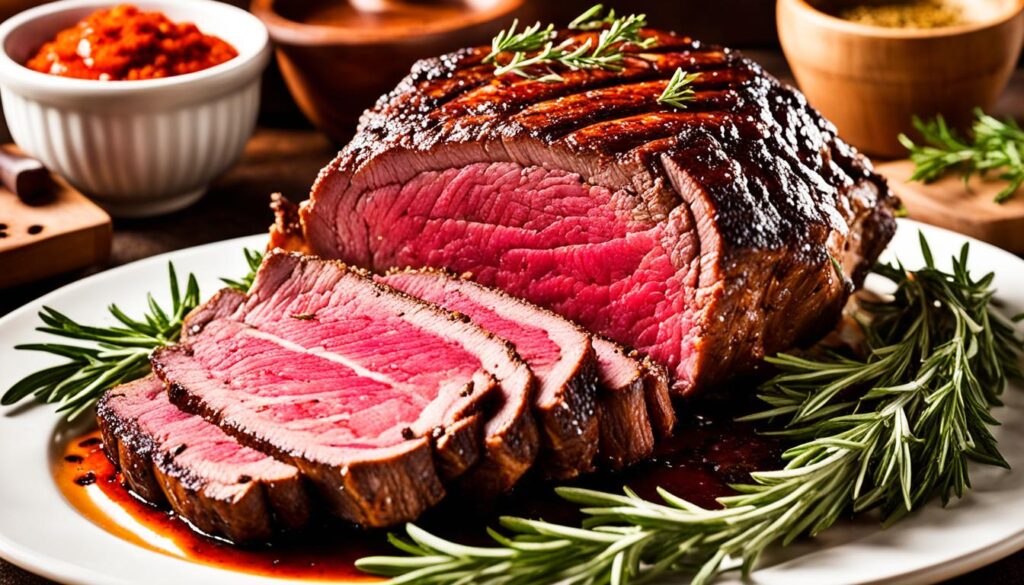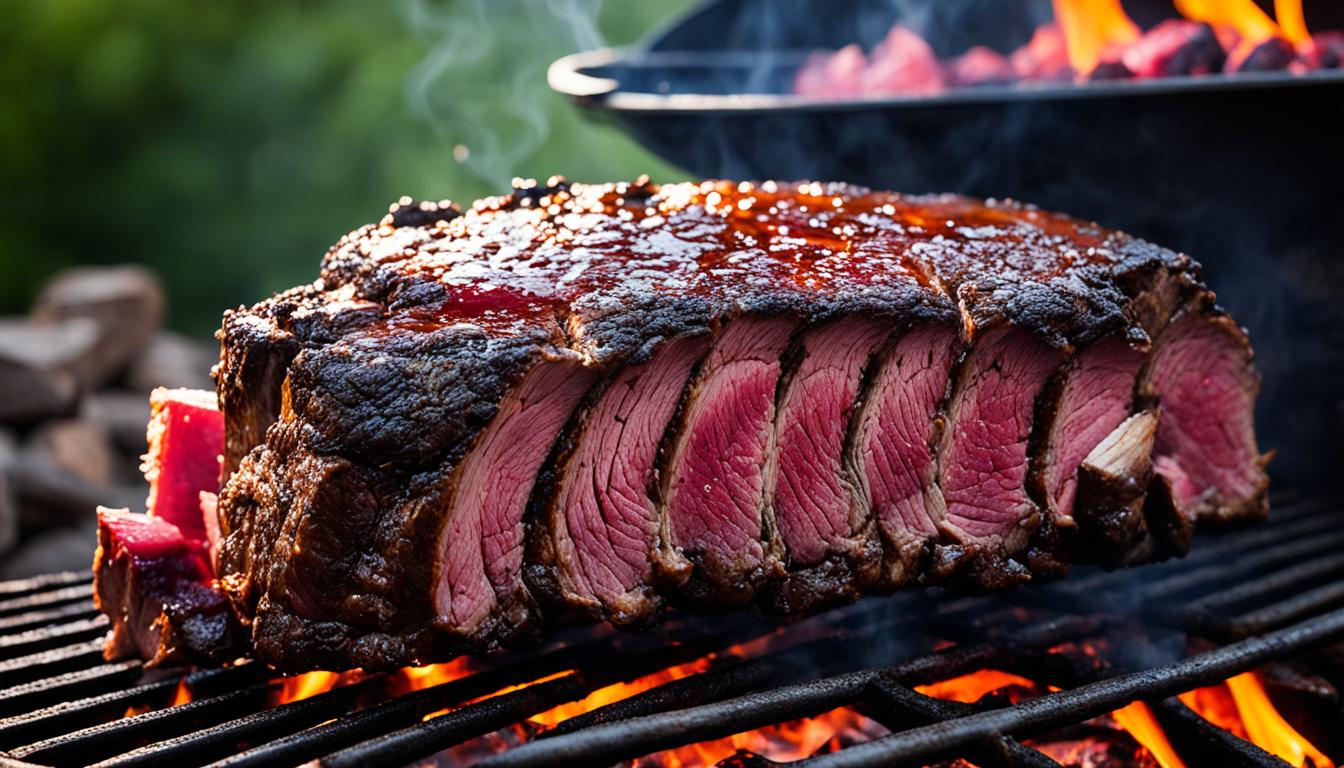Are you looking to elevate your cooking skills and indulge in a mouthwatering feast? Look no further than the grill roasted whole bison boneless prime rib roast. This delectable dish is known for its succulence and tenderness, making it the perfect centerpiece for any special occasion. But how do you achieve that perfect balance of flavor and juiciness?
Today, we will explore the secrets to cooking a delicious grill roasted bison prime rib that will leave your guests impressed and craving for more. From selecting the best cut of bison prime rib to crafting the ideal seasoning blend and mastering grilling techniques, we have you covered. Get ready to unlock the wild flavors and unrivaled tenderness of bison prime rib.
Key Takeaways:
- Grill roasted whole bison boneless prime rib roast is a luxurious choice for a special occasion meal.
- Choosing a high-quality cut of bison with marbling throughout ensures flavor and tenderness.
- An ideal seasoning blend includes kosher salt, black pepper, garlic powder, and fresh herbs.
- Grilling techniques like the sear-first approach or reverse-sear method produce perfectly cooked bison prime rib.
- Mastering the art of grill roasted bison prime rib will impress your guests and elevate your culinary skills.
Selecting the Perfect Prime Rib
When it comes to creating an exceptional bison prime rib roast, selecting the right cut is crucial. By choosing a high-quality boneless prime rib roast, you ensure a tender and flavorful result that will impress your guests.
Here are some tips to help you choose the best bison prime rib:
- Look for marbling throughout the meat – Marbling is the distribution of fat within the muscle tissue and is a key indicator of flavor and tenderness. Opt for a roast with visible marbling.
- Consult with a butcher – Butchers are experts when it comes to meat selection. Seek their advice on the best cuts of bison for prime rib roast.
- Choose “prime” or “choice” grade – The grade of the meat refers to its quality. Prime and choice grades are known for their superior flavor and tenderness.
- Consider the number of bones – Prime rib roasts can vary in the number of ribs they include. A classic prime rib usually consists of 2 to 7 ribs, but the number of bones can be a personal preference.
Preparing the prime rib before grilling is also essential for a successful outcome:
- Trim excess fat – While fat adds flavor, it’s important to trim any excess fat while leaving a thin, even layer for flavor enhancement during the cooking process.
- Dry brine with coarse salt – Applying a generous amount of coarse salt and desired seasonings creates a dry brine, which enhances the flavor and tenderness of the prime rib.
- Allow the seasoned roast to rest – After applying the dry brine, let the seasoned prime rib rest at room temperature for at least 45 minutes. This resting period allows the seasonings to penetrate the meat, resulting in a flavorful roast.
To further illustrate the process, below is a visual guide to selecting the perfect prime rib:
| Step | Description |
|---|---|
| 1. | Look for marbling throughout the meat. |
| 2. | Consult with a butcher for advice. |
| 3. | Choose “prime” or “choice” grade. |
| 4. | Consider the number of bones. |
| 5. | Trim excess fat while preserving an even layer. |
| 6. | Dry brine the roast with coarse salt and desired seasonings. |
| 7. | Let the seasoned prime rib rest at room temperature for at least 45 minutes. |
Now that you know how to select the perfect prime rib, let’s move on to crafting the ideal seasoning blend to further elevate the flavor profile of your bison prime rib roast.
Crafting the Perfect Seasoning Blend
The seasoning blend is key to enhancing the natural flavors of bison prime rib. To create a juicy bison prime rib, we recommend using the following seasoning mix:
| Seasoning Ingredients | Measurement |
|---|---|
| Kosher salt | 2 tablespoons |
| Black pepper | 1 tablespoon |
| Garlic powder | 1 tablespoon |
| Fresh thyme (chopped) | 1 tablespoon |
| Fresh rosemary (chopped) | 1 tablespoon |
The kosher salt provides a coarse texture and adheres well to the meat, ensuring an evenly seasoned crust. Black pepper adds a necessary heat element, while garlic powder contributes a savory depth. The fresh herbs, thyme and rosemary, infuse the prime rib with aromatic earthiness.
When applying the seasoning blend, start by coating the prime rib with olive oil to help the spices and herbs adhere better and lock in moisture. Massage the spice mixture thoroughly into every inch of the roast, including the bone area, to ensure flavorful bites.
Expert Tip:
For an extra burst of flavor, you can customize the seasoning blend by adding additional herbs or spices that complement the rich taste of bison.
With the perfect seasoning blend, your bison prime rib will be packed with flavor and juiciness, creating a truly memorable dining experience.
Grilling Techniques for Prime Rib
Grilling prime rib requires attention to detail and an understanding of the cooking process. The preferred method is indirect heat, which involves cooking the meat slowly to the perfect internal temperature without charring the exterior. This allows for even cooking and ensures a juicy and tender bison prime rib.
There are two popular techniques that can be used to achieve a mouthwatering grilled bison prime rib: the sear-first approach and the reverse-sear method.
The sear-first approach involves searing the prime rib on high heat to create a savory crust. This initial sear locks in the juices and adds flavor to the meat. After the sear, the prime rib is cooked over lower heat to reach the desired internal temperature. This technique results in a juicy and succulent prime rib with a flavorful crust.
The reverse-sear method, on the other hand, involves cooking the prime rib over low heat until it is nearly cooked to the desired internal temperature. This slow cooking allows the meat to retain its moisture and tenderness. Once the prime rib is nearly cooked, it is then finished over high heat to create a crispier crust. The reverse-sear method produces a prime rib with a perfectly cooked interior and a deliciously crispy exterior.
Regardless of the technique you choose, patience and precise temperature control are key to achieving a perfectly cooked and juicy bison prime rib. It is important to monitor the internal temperature of the meat using a meat thermometer to ensure it reaches your desired level of doneness.
“Grilling prime rib is a delicate process that requires precision and attention. By using indirect heat and employing either the sear-first approach or the reverse-sear method, you can create a bison prime rib that is tender, flavorful, and cooked to perfection.”
Now that we have explored the grilling techniques for prime rib, let’s move on to the final section where we will conclude our journey into the world of grill roasted bison prime rib and its exquisite flavors.

| Grilling Technique | Description |
|---|---|
| Sear-First Approach | High-heat sear followed by cooking over lower heat. Results in a juicy prime rib with a flavorful crust. |
| Reverse-Sear Method | Slow cooking over low heat followed by a high-heat finish. Produces a prime rib with a perfectly cooked interior and a crispy exterior. |
Conclusion
Grill roasted whole bison boneless prime rib roast is the epitome of luxury and flavor, perfect for any special occasion. With the right prime rib cut, a carefully crafted seasoning blend, and mastery of grilling techniques, you can create an unforgettable and mouthwatering dish that will impress your guests.
Whether you’re a grilling expert or just starting out, this recipe will elevate your culinary skills and provide a truly memorable dining experience. The succulent and tender bison meat, infused with the aromatic flavors of herbs and spices, guarantees a feast that will be the talk of the town.
So fire up your grill, follow our expert guidance, and savor the bold taste of premium bison roast. Explore the wild possibilities of bison meat recipes and indulge in the deliciousness of grill roasted whole bison boneless prime rib roast.
